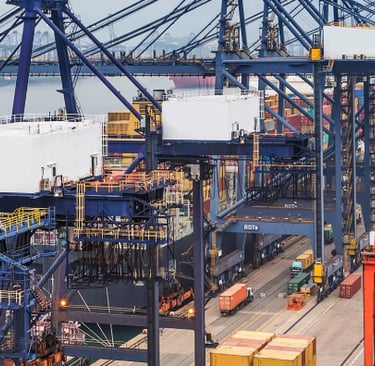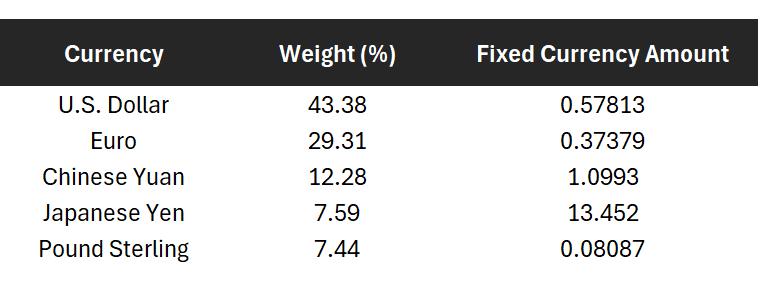SDR - Special Drawing Rights - Cargo Claims Handling & Recovery - LawCite Advocates
LawCite Advocates specializes in Cargo Claims Handling & Recovery, with expert focus on SDR - Special Drawing Rights calculations and liability assessment for effective dispute resolution and settlement.
CARGO CLAIMS
LawCite Advocates
6/20/20256 min read


As of May 4, 2025, the shipping industry continues to rely on Special Drawing Rights (SDRs) as the standard unit for calculating liability limitations in cargo claims. This article provides a detailed breakdown of SDR calculations under different maritime conventions, with practical examples using Indian Rupee (INR) to guide claim handlers through this often complex process.
What are Special Drawing Rights?
Special Drawing Rights (SDRs) are an international reserve asset created by the International Monetary Fund (IMF) in 1969 to supplement member countries' official reserves. In the context of maritime law, SDRs serve as the standard unit for calculating carrier liability limits, providing a stable international reference point regardless of currency fluctuations.
The SDR is not a currency per se, but rather a potential claim on freely usable currencies of IMF members. Its value is determined by a basket of five major currencies: the U.S. dollar, Euro, Chinese yuan, Japanese yen, and British pound sterling.
Current SDR Basket Composition
As of August 2023, the SDR basket consists of the following currencies with their respective weights:
These weights reflect each currency's importance in international trade and national foreign exchange reserves2. The IMF reviews and adjusts the SDR valuation basket every five years9.
How to Calculate SDR Value in Indian Rupee (INR)
Calculating the SDR value in INR involves a multi-step process:
Step 1: Obtain Current Exchange Rates
First, you need to find the current exchange rates between each of the five basket currencies and INR. These rates can be obtained from reliable financial sources or central bank websites.
Step 2: Calculate Individual Currency Contributions
For each currency in the basket, multiply its fixed amount by its exchange rate against INR.
For example, using hypothetical exchange rates (as of May 4, 2025):
1 USD = 75 INR
1 EUR = 90 INR
1 CNY = 11 INR
1 JPY = 0.65 INR
1 GBP = 105 INR
Calculate each currency's contribution:
USD contribution: 0.57813 × 75 = 43.36 INR
EUR contribution: 0.37379 × 90 = 33.64 INR
CNY contribution: 1.0993 × 11 = 12.09 INR
JPY contribution: 13.452 × 0.65 = 8.74 INR
GBP contribution: 0.080870 × 105 = 8.49 INR
Step 3: Sum the Values
Add all the individual currency contributions to get the total SDR value in INR:
43.36 + 33.64 + 12.09 + 8.74 + 8.49 = 106.32 INR
Therefore, 1 SDR = 106.32 INR in this example.
SDR Limitations Under Different Maritime Conventions
The calculation method varies slightly depending on which maritime convention applies to your cargo claim:
Hague-Visby Rules
Under the Hague-Visby Rules, the carrier's liability is limited to the higher of:
666.67 SDR per package or unit
2 SDR per kilogram of gross weight of the goods
Hamburg Rules
Under the Hamburg Rules, the carrier's liability is limited to the higher of:
835 SDR per package or unit
2.5 SDR per kilogram of gross weight of the goods
The Hamburg Rules also introduce a limit for delay, capped at 2.5 times the freight payable for the delayed goods, but not exceeding the total freight payable under the contract of carriage11.
Practical Calculation Examples
Example 1: Single Heavy Package Under Hague-Visby Rules
Scenario: A single machinery part weighing 5,000 kg valued at INR 2,000,000 is damaged during transit.
Calculation:
Package limitation: 666.67 SDR × 106.32 INR = 70,880.78 INR
Weight limitation: 5,000 kg × 2 SDR × 106.32 INR = 1,063,200 INR
Since the weight-based limitation (1,063,200 INR) is higher than the package-based limitation (70,880.78 INR), the liability limit is 1,063,200 INR.
Example 2: Multiple Packages in a Container Under Hamburg Rules
Scenario: A container with 200 cartons of electronics, each weighing 25 kg (total 5,000 kg), with a total value of INR 3,500,000 is lost at sea.
Calculation:
Package limitation: 200 packages × 835 SDR × 106.32 INR = 17,757,480 INR
Weight limitation: 5,000 kg × 2.5 SDR × 106.32 INR = 1,329,000 INR
Since the package-based limitation (17,757,480 INR) is higher than the weight-based limitation (1,329,000 INR), the liability limit is 17,757,480 INR.
Example 3: Container as a Package Dispute
Scenario: A container with 200 drums of lubricating oil weighing 27,000 kg valued at INR 5,000,000 is damaged, but the bill of lading only mentions "1 container" without listing the contents.
Calculation if container is considered one package (under Hague-Visby):
Package limitation: 1 package × 666.67 SDR × 106.32 INR = 70,880.78 INR
Weight limitation: 27,000 kg × 2 SDR × 106.32 INR = 5,741,280 INR
The weight-based limitation (5,741,280 INR) would apply.
Calculation if each drum is considered a package (under Hague-Visby):
Package limitation: 200 packages × 666.67 SDR × 106.32 INR = 14,176,156.80 INR
Weight limitation: 27,000 kg × 2 SDR × 106.32 INR = 5,741,280 INR
The package-based limitation (14,176,156.80 INR) would apply.
This example illustrates the critical importance of how packages are described in the bill of lading.
When to Calculate SDR Values in the Claims Process
SDR calculations should be performed at several key stages:
Initial Claim Assessment: Calculate preliminary liability limits when a claim is first received to establish a framework for negotiations.
Before Settlement Negotiations: Recalculate using the most current SDR rates before entering serious negotiations, as currency fluctuations may affect the limitation amount.
Prior to Legal Proceedings: Update calculations before commencing legal action to ensure accuracy of claimed amounts.
Which Date's Exchange Rate to Use
The appropriate date for determining the SDR value is a matter of some complexity and may vary by jurisdiction. Common approaches include:
Date of Judgment/Settlement: Many courts prefer using the SDR value on the date of judgment or settlement.
Date of Delivery/Damage: Some jurisdictions use the date when the goods were delivered or when the damage occurred.
Date of Payment: In some cases, the date of actual payment may be used.
Claim handlers should consult legal advisors about the appropriate date to use in their specific jurisdiction.
Critical Considerations for Claim Handlers
Package Definition and Documentation
The definition of "package or unit" is crucial for accurate calculation. Courts have interpreted this differently across jurisdictions. For containerized cargo, whether each item inside a container constitutes a separate package depends on how it is described in the bill of lading.
Container Issues
When dealing with containerized shipments, the bill of lading description is critical:
If the bill of lading lists the number of packages inside a container, each package is counted separately for limitation purposes.
If the bill of lading only references the container without enumerating its contents, the entire container might be considered a single package.
Special Cases
Bulk Cargo: For bulk shipments without distinct packages, the weight-based limitation will typically apply.
Deck Cargo: Under Hague-Visby Rules, deck cargo is excluded unless it is clearly stated in the bill of lading that the cargo is stowed on deck.
Live Animals: Under Hague-Visby Rules, live animals are excluded, but Hamburg Rules include them with specific provisions for inherent risks.
Updating SDR Values
The IMF calculates the value of the SDR daily based on market exchange rates. Claim handlers should:
Use the most current SDR values for accurate calculations
Understand that SDR values fluctuate daily with currency markets
Keep records of the specific SDR values used in calculations with their source and date
Common Pitfalls to Avoid
Using Outdated Exchange Rates: Always use the most current exchange rates available from reliable sources.
Miscounting Packages: Carefully review shipping documents to determine the correct number of packages.
Ignoring Bill of Lading Descriptions: The way goods are described in the bill of lading can significantly impact limitation calculations.
Applying the Wrong Convention: Verify which maritime convention applies to the specific shipment before calculating limitations.
Misinterpreting "Package or Unit": Ensure proper interpretation of what constitutes a package or unit under the applicable convention and jurisdiction.
Conclusion
Calculating SDR values for cargo claims requires attention to detail and a thorough understanding of the applicable maritime conventions. By following the step-by-step process outlined in this article and considering the nuances of different shipping scenarios, claim handlers can accurately determine liability limitations and negotiate claims effectively.
The shift from the Hague-Visby Rules (666.67 SDR per package/2 SDR per kg) to the Hamburg Rules (835 SDR per package/2.5 SDR per kg) represents a significant increase in carrier liability limits. Claim handlers must stay informed about which convention applies to their specific cases to ensure accurate calculations.
Proper documentation of goods, particularly in bills of lading, plays a crucial role in determining limitation amounts, especially for containerized shipments. A well-informed approach to SDR calculations will lead to more equitable settlements and efficient claim resolution in the complex world of international shipping.
Need Expert Help With Your Cargo Claim?
Every detail from how your cargo is documented to how liability is calculated can decide the outcome. The Cargo Claims Division at LawCite Advocates is built to protect your interests, challenge unfair denials, and ensure rightful recovery.
📧 Email: cargoclaims@lawcite.in


Address: - LawCite Advocates, Onlooker Building, 4th Floor, Office No. 32, Sir. PM Street, Opp. Axis Bank, Bora Bazaar Precinct, Fort, Mumbai - 400001, Maharashtra, India
Ph:- (+91) 9967318992
E :- contact@lawcite.in | vipinsharma@lawcite.in